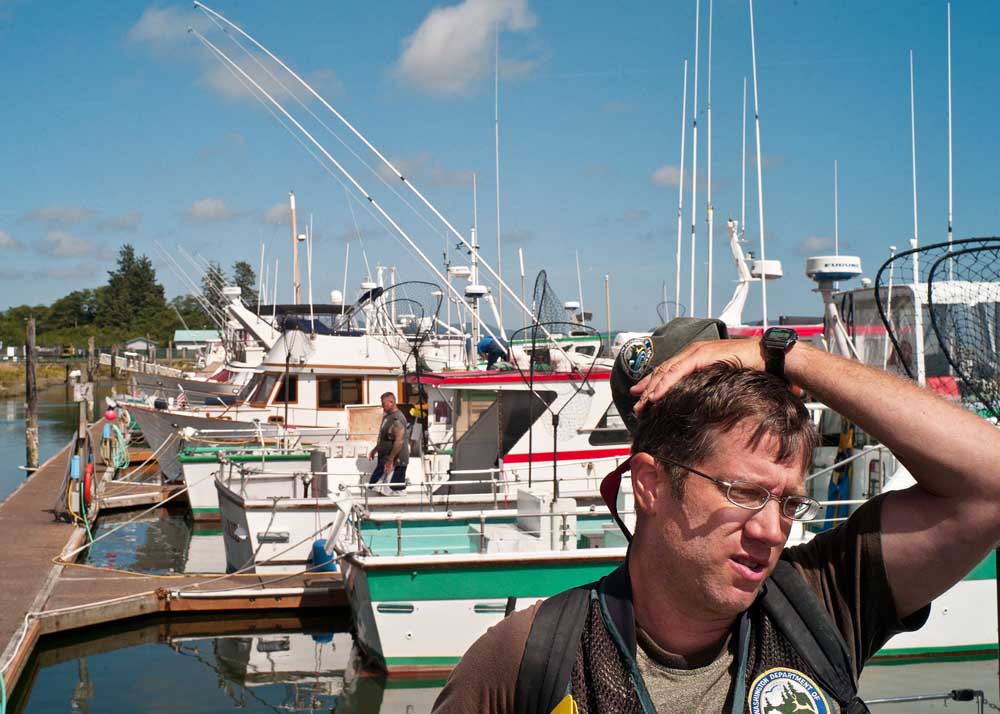Salmon burst back
Published 6:40 am Friday, August 15, 2014

- Washington Fish and Wildlife sampler Kurt Karageorge and a colleague were scrambling to keep up with incoming salmon at the Port of Ilwaco last week.
COLUMBIA RIVER, Wash. — Everything has been upside down and moving twice as fast since the recreational Buoy 10 fishery opened for salmon fishing on the Lower Columbia River Aug. 1.
It’s taking longer to get to good fishing spots than it’s taking to land their limit in fish, sport fishermen told Ilwaco-based Washington Department of Fish and Wildlife port sampler Kurt Karageorge.
“There’s so many fish rolling in this year,” said Ron Roler, Columbia River policy coordinator for WDFW. “The sheer numbers are just so huge it almost defies logic.”
By Aug. 4, WDFW had recorded more than 1,000 Chinook retained for Buoy 10. Last year, the department saw only 340 Chinook retained in the first four days. Preseason catch expectations this year are for 45,700 Chinook and 56,500 coho, and fisheries managers have forecast a record run of 1.5 million returning fall Chinook.
At the Sportsmen’s Cannery and Smokehouse in Ilwaco, the normal summer processing routine is backwards. On a typical August day, they would spend the morning processing commercial-caught tuna. The sport fishermen normally wouldn’t come back until the afternoon and by then the tables would be clear and ready for salmon.
This year, they’ve been sprinting to keep up with the salmon coming through the door, said co-owner Tina Ward. They haven’t even been getting to the tuna until later in the afternoon.
“From 8:30 to 12, it’s as fast as we can go,” Ward said. “As soon as we open the doors it’s salmon for the first four hours.”
And the Chinook that have been coming in are big, an average of 25 to 30 pounds, she said. As fall approaches, this weight will only increase.
Sport fishermen out on the ocean are also doing well. They are catching their limit in just hours, according to Sea Breeze Charters in Ilwaco.
“The ocean is as good as it’s been since 2001,” said Butch Smith, a commissioner for the Port of Ilwaco and owner of Coho Charters. His boats have been booked solid.
But along with all this bounty come several challenges.
In the first week of the Buoy 10 fishery, small fishing boats lined the river, stretching far up and down, disappearing in the early morning fog. Boats sprinted across the water, trailing white wakes. In the shipping channels near the river’s south bank, huge ships passed under the bridge. As the different vessels eased around each other, the big ships blasted warnings with their horns.
All this traffic on the river means there’s a greater chance for boat-related accidents and conflicts between users. The U.S. Coast Guard has been busy fielding calls since Buoy 10 opened. Coast guardsmen based at the Cape Disappointment Coast Guard Station were so busy last weekend organizing tows, towing fishing boats and rescuing or assisting anglers they weren’t able to make an appearance at Astoria’s annual Regatta celebration.
While none of the calls have been serious yet, there is always the potential, said Petty Officer David Mosley.
The Coast Guard and Coast Guard Auxiliary plans to patrol the waters and be present at docks to educate people about boat safety and to perform safety checks.
Though the weather has been “phenomenally beautiful,” sport fishermen still need to be aware of wind and tidal changes, Mosley said. What might start out as a quiet morning on the river with no wind and smooth water can change quickly.
In Ilwaco, the sports fishery is mostly a boon, briefly boosting traffic through the port and filling up the marina. Right now, no slips are available in Ilwaco or Chinook for most of August.
The only problem has been the channel. The U.S. Army Corps of Engineers planned to begin dredging the increasingly shallow channel connecting the marina to the river this month, but the bidding process and awarding of contracts has dragged on and the port has yet to see any dredge work begin, Smith said.
“There’s a really right spot coming in to the Ilwaco channel,” he said. “It’s very narrow.” And boats have had trouble getting past each other.
As Buoy 10 continues, fisheries managers are keeping a close eye on it. Last year, Roler said they observed the run could be bigger than anticipated. Managers took a gamble and changed the fishery to “mark selective,” limiting what fishermen could keep, and holding out for the big run. The fishery would have closed early otherwise.
The fast start this year could mean an early closure, but it’s hard to predict at this point, Roler said.
“You try and do the best you can with the data to make a fishery continue to operate,” he said. “If you start up and you’re already over 1,000 fish in the first week, you start scratching your head.”
But, he added, there’s no guarantee the fishing will continue at that rate. Rain, wind and all sorts of environmental factors could change the situation in hours.
‘The ocean is as good as it’s been since 2001.’
— Butch Smith
a commissioner for the Port of Ilwaco and owner of Coho Charters.




